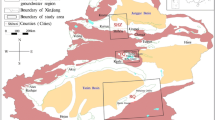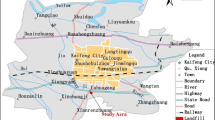Abstract
The difficulty of defining the sources of pollution limits the effectiveness of water pollution control measures. This study focused on the Guangrong Canal, a contaminated canal that has been subjected to multiple recovery efforts with unsatisfactory results. Groundwater was first investigated upstream of Guangrong Canal. In Aug 2014, the organic pollutants detected in a sample of groundwater were O-toluidine, aniline, phenol, 2,4-dichlorophenol, phthalate (2-ethylhexyl) ester (DEHP), and 4-nitrotoluene. In Jan 2015, benzene, aniline, O-toluidine, phthalate (2-ethylhexyl) ester (DEHP), and naphthalene were detected in groundwater as well. Additional organic pollutants such as C15–C28, C29–C36, O-toluidine, 4-nitrotoluene, and so on were detected in the soil. The distribution of the organic pollutants indicated that a sewage pit was the pollutant source. The organic pollutants were consistent with the production of organic acids at this abandoned site. We investigated the area around the site to identify the degradation pathway and pollutant source. Based on the results, a pump-and-treat method was adopted at the abandoned site. We then sampled the groundwater 6 months later to evaluate the recovery method. To address pollution of surface waters such as the Guangrong Canal, an investigation of the groundwater and soil from upstream should be performed; the results of the present study indicate that the pump-and-treat method can be most effective for recovering a chemical site.





Similar content being viewed by others
References
Atmadja J, Bagtzoglou AC (2001) State of the art report on mathematical methods for groundwater pollution source identification. Environ Forensics 2:205–214
Bhutiani R, Kulkarni DB, Khanna DR, Gautam A (2016) Water quality, pollution source apportionment and health risk assessment of heavy metals in groundwater of an industrial area in North India. Expo Health 8:3–18
Bi C, Liang Y, Xu Y (2015) Fate and transport of phthalates in indoor environments and the influence of temperature: a case study in a test house. Environ Sci Technol 49:9674–9681
Boor BE, Liang Y, Crain NE, Järnström H, Novoselac A, Xu Y (2015) Identification of phthalate and alternative plasticizers, flame retardants, and unreacted isocyanates in infant crib mattress covers and foam. Environ Sci Technol Lett 2:89–94
Chang M, McBroom MW, Beasley RS (2004) Roofing as a source of nonpoint water pollution. J Environ Manage 73:307–315
Dong WH, Zhang Y, Lin XY, Du SH (2014) Prediction of 1,2,4- trichlorobenzene natural attenuation in groundwater at a landfill in Kaifeng, China. Environ Earth Sci 71:941–948
Dong WH, Lin XY, Du SH (2015) Risk Assessment for the organic contaminations in shallow groundwater around a leaching landfill site in Kaifeng, China. Environ Earth Sci 74:2749–2756
Dowd BM, Press D, Los Huertos M (2008) Agricultural nonpoint source water pollution policy: the case of California’s Central Coast. Agric Ecosyst Environ 128:151–161
Gunkel G, Kosmol J, Sobral M, Rohn H, Montenegro S, Aureliano J (2007) Sugar cane industry as a source of water pollution–Case study on the situation in Ipojuca River, Pernambuco, Brazil. Water Air Soil Pollut 180:261–269
Gurarslan G, Karahan H (2015) Solving inverse problems of groundwater-pollution-source identification using a differential evolution algorithm. Hydrogeol J 23:1109–1119
Kharat MM, Adiani V, Variyar P, Sharma A, Singhal RS (2016) Antioxidant compounds in traditional Indian Pickles may prevent the process-induced formation of benzene. J Food Prot 79:123–131
Li PY, Qian H, Wu JH (2014) Origin and assessment of groundwater pollution and associated health risk: a case study in an industrial park, Northwest China. Environ Geochem Health 36:693–712
Li PY, Li XY, Meng XY, Li MN, Zhang YT (2016) Appraising groundwater quality and health risks from contamination in a semiarid region of Northwest China. Expo Health. doi:10.1007/s12403-016-0205-y
Mackuľak T, Takáčová A, Gál M, Marton M, Ryba J (2015) PVC degradation by Fenton reaction and biological decomposition. Polym Degrad Stab 120:226–231
Mahar PS, Datta B (2001) Optimal identification of ground-water pollution sources and parameter estimation. J of Water Resour Plan Manage 127:20–29
Pai H, Villamizar SR, Harmon TC (2015) High resolution synoptic salinity mapping to identify groundwater-surface water discharges in lowland rivers. Environ Sci Technol 49:4842–4850
Patterson JJ, Smith C, Bellamy J (2013) Understanding enabling capacities for managing the “wicked problem” of nonpoint source water pollution in catchments: a conceptual framework. J Environ Manage 128:441–452
Qian JZ, Wang LL, Liu Y, Wu BR, Wang XM (2015) Distribution of nitrate and its implication for the contaminant source in groundwater of Huaibei Plain, Anhui Province. Geosci J 19:537–545
Rabotyagov SS, Valcu AM, Kling CL (2014) Reversing property rights: practice-based approaches for controlling agricultural nonpoint-source water pollution when emissions aggregate nonlinearly. Am J Agric Econ 96:397–419
Schulz R (2004) Field studies on exposure, effects, and risk mitigation of aquatic nonpoint-source insecticide pollution. J Environ Qual 33:419–448
Shao Y, Gao SX, Yang B, Cai BC, Wang LS (2004) Effect of HP-β-CD on the biodegradation of nitrobenzene at high concentration by Acinetobacter sp. Acta Scientiae Circumstantiae 24:690–695
Song S, He Z, Chen J (2007) US/O3 combination degradation of aniline in aqueous solution. Ultrason Sonochem 14:84–88
Srivastava D, Singh RM (2015) Groundwater system modeling for simultaneous identification of pollution sources and parameters with uncertainty characterization. Water Resour Manage 29:4607–4627
Stuart ME, Lapworth DJ, Thomas J, Edwards L (2014) Fingerprinting groundwater pollution in catchments with contrasting contaminant sources using microorganic compounds. Sci Total Environ 468:564–577
Su XS, Yuan WZ, Xu W, Du SH (2015) A groundwater vulnerability assessment method for organic pollution: a validation case in the Hun River basin, Northeastern China. Environ Earth Sci 73:467–480
Tran NH, Gin KYH, Ngo HH (2015) Fecal pollution source tracking toolbox for identification, evaluation and characterization of fecal contamination in receiving urban surface waters and groundwater. Sci Total Environ 538:38–57
Wu J, Li P, Qian H et al (2014) Using correlation and multivariate statistical analysis to identify hydrogeochemical processes affecting the major ion chemistry of waters: a case study in Laoheba phosphorite mine in Sichuan, China. Arabian J Geosciences 7(10):3973–3982
Yan CA, Zhang WC, Zhang ZJ, Liu YM, Cai D, Nie N (2015) Assessment of water quality and identification of polluted risky regions based on field observations & GIS in the Honghe River Watershed, China. PloS One 10:e119130
Acknowledgments
Thanks to the Shanghai SEP Analytical Service Co., Ltd. for offering the professional detection and National Natural Science Foundation of China for funding (41502223).
Author information
Authors and Affiliations
Corresponding author
Rights and permissions
About this article
Cite this article
Kang, B., Wang, D. & Du, S. Source Identification and Degradation Pathway of Multiple Persistent Organic Pollutants in Groundwater at an Abandoned Chemical Site in Hebei, China. Expo Health 9, 135–141 (2017). https://doi.org/10.1007/s12403-016-0228-4
Received:
Revised:
Accepted:
Published:
Issue Date:
DOI: https://doi.org/10.1007/s12403-016-0228-4




